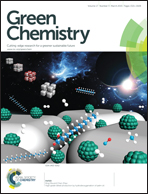Solvent effects in heterogeneous selective hydrogenation of acetophenone: differences between Rh/C and Rh/Al2O3 catalysts and the superiority of water as a functional solvent†
Abstract
Selective hydrogenation of acetophenone (AP) to 1-phenylethanol (PhE) was investigated over Rh/Al2O3 and Rh/C catalysts in 13 solvents including water and conventional organic solvents. Strong solvent effects on the overall rate of AP conversion were observed in different manners depending on the catalysts used. The conversion obtained is correlated with hydrogen-bond-donation (HBD) capability for Rh/C but with hydrogen-bond-acceptance (HBA) capacity for Rh/Al2O3. The solvent effects should result from interactions between the carbonyl group of AP and the solvent molecules through hydrogen bonding for Rh/C and from those between the solvent molecules and the catalyst surface for Rh/Al2O3 having HBD hydroxyl groups on its surface. Water is the most effective functional solvent in the selective hydrogenation of AP for C and Al2O3-supported Rh catalysts due to its high HBD capability (α) and low HBA capability (β), respectively. For the hydrogenation with Rh/Al2O3 in water, its large polarity/polarizability index (π*) may contribute to the high selectivity to PhE.


 Please wait while we load your content...
Please wait while we load your content...